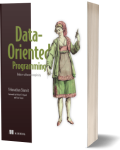Data-Oriented Programming
Software Development
Book Details
Book Title
Data-Oriented Programming
Author
Yehonathan Sharvit
Publisher
Manning Publications
Publication Date
2022
ISBN
9781617298578
Number of Pages
426
Language
English
Format
File Size
7.1MB
Subject
Software Engineering; Databases; Debugging; Data Structures; Concurrency; Object-Oriented Programming
Table of Contents
- Data-Oriented Programming
- brief contents
- contents
- forewords
- preface
- acknowledgments
- about this book
- about the author
- about the cover illustration
- dramatis personae
- Part 1—Flexibility
- Chapter 1: Complexity of object- oriented programming
- 1.1 OOP design: Classic or classical?
- 1.2 Sources of complexity
- Summary
- Chapter 2: Separation between code and data
- 2.1 The two parts of a DOP system
- 2.2 Data entities
- 2.3 Code modules
- 2.4 DOP systems are easy to understand
- 2.5 DOP systems are flexible
- Summary
- Chapter 3: Basic data manipulation
- 3.1 Designing a data model
- 3.2 Representing records as maps
- 3.3 Manipulating data with generic functions
- 3.4 Calculating search results
- 3.5 Handling records of different types
- Summary
- Chapter 4: State management
- 4.1 Multiple versions of the system data
- 4.2 Structural sharing
- 4.3 Implementing structural sharing
- 4.4 Data safety
- 4.5 The commit phase of a mutation
- 4.6 Ensuring system state integrity
- 4.7 Restoring previous states
- Summary
- Chapter 5: Basic concurrency control
- 5.1 Optimistic concurrency control
- 5.2 Reconciliation between concurrent mutations
- 5.3 Reducing collections
- 5.4 Structural difference
- 5.5 Implementing the reconciliation algorithm
- Summary
- Chapter 6: Unit tests
- Part 2—Scalability
- Chapter 7: Basic data validation
- 7.1 Data validation in DOP
- 7.2 JSON Schema in a nutshell
- 7.3 Schema flexibility and strictness
- 7.4 Schema composition
- 7.5 Details about data validation failures
- Summary
- Chapter 8: Advanced concurrency control
- 8.1 The complexity of locks
- 8.2 Thread-safe counter with atoms
- 8.3 Thread-safe cache with atoms
- 8.4 State management with atoms
- Summary
- Chapter 9: Persistent data structures
- 9.1 The need for persistent data structures
- 9.2 The efficiency of persistent data structures
- 9.3 Persistent data structures libraries
- 9.4 Persistent data structures in action
- Summary
- Chapter 10: Database operations
- 10.1 Fetching data from the database
- 10.2 Storing data in the database
- 10.3 Simple data manipulation
- 10.4 Advanced data manipulation
- Summary
- Chapter 11: Web services
- 11.1 Another feature request
- 11.2 Building the insides like the outsides
- 11.3 Representing a client request as a map
- 11.4 Representing a server response as a map
- 11.5 Passing information forward
- 11.6 Search result enrichment in action
- Delivering on time
- Summary
- Part 3—Maintainability
- Chapter 12: Advanced data validation
- 12.1 Function arguments validation
- 12.2 Return value validation
- 12.3 Advanced data validation
- 12.4 Automatic generation of data model diagrams
- 12.5 Automatic generation of schema-based unit tests
- 12.6 A new gift
- Summary
- Chapter 13: Polymorphism
- 13.1 The essence of polymorphism
- 13.2 Multimethods with single dispatch
- 13.3 Multimethods with multiple dispatch
- 13.4 Multimethods with dynamic dispatch
- 13.5 Integrating multimethods in a production system
- Summary
- Chapter 14: Advanced data manipulation
- 14.1 Updating a value in a map with eloquence
- 14.2 Manipulating nested data
- 14.3 Using the best tool for the job
- 14.4 Unwinding at ease
- Summary
- Chapter 15: Debugging
- 15.1 Determinism in programming
- 15.2 Reproducibility with numbers and strings
- 15.3 Reproducibility with any data
- 15.4 Unit tests
- 15.5 Dealing with external data sources
- Farewell
- Summary
- Appendix A—Principles of data-oriented programming
- Appendix B—Generic data access in statically-typed languages
- Appendix C—Data-oriented programming: A link in the chain of programming paradigms
- Appendix D—Lodash reference
- index
